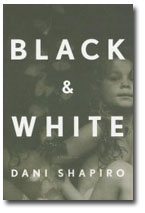Books |
Black & White
Dani Shapiro
By
Published: Jan 01, 2007
Category:
Fiction
There’s a long tradition of turning kids into money. Shirley Jackson — you recall her from English class; she wrote “The Lottery” — wrote several books about her “demon” children. More recently, a New Yorker writer named Adam Gopnik has turned his four-year-old daughter and her imaginary friend into characters so brilliant and quotable that I, for one, don’t believe a word of it.
The question of the media exploitation of children by artistic parents is one I’ve lived with twice now, once with my step-children, now with our daughter. Kids do say the darndest things, and if you are of a mind to do so, you can turn those quips into money. I don’t do it, because all of the kids involved frown on it and because, at a level, writing about your offspring strikes me as a mild form of child abuse.
Why is that an easier decision for many other writers? Because the pictures are words, and they zoom into the readers’ heads without revealing the actual child. In a photograph…it’s different.
Afew decades ago, a photographer named Sally Mann made her reputation with a series of pictures of her young children. The kids were mostly naked. And they were photographed with an intimacy not usually seen outside of — well, outside of pornography. Mann was praised by some, savaged by others. But she got famous, which may have been the point.
Now Dani Shapiro, a writer unafraid of tough subjects, has weighed in with a novel that asks — and answers — two questions that almost everyone who saw Sally Mann’s pictures surely asked: What was she thinking? What did her kids think? And, of course, the follow-up: Ten, twenty years down the line, how do the kids feel about these photographs?
In Shapiro’s novel, the photographer is Ruth Dunne. She has two daughters, Clara and Robin; she only photographed Clara. Unsurprisingly, Clara bolted from home at 18 and now lives on a remote Maine island with her man and her daughter. She never speaks to her mother, has kept her past a secret from her 9-year-old kid. To say that her childhood as the star of her mother’s photographs is the central event of her life is to understate — those pictures have, literally, frozen her.
A decade after Clara fled New York, Ruth Dunne falls into her final decline. And Robin summons Clara home for the kind of deathbed get-together that is the meat-and-potatoes of a hundred lousy novels. Or so I expected as I started the book and followed Clara past the bookstore on Broadway that now sells cosmetics, past the table piled high with discounted review copies of new books, to the Apthorp, the block-square apartment building that was her childhood home.
I lived in the Apthorp for many years. And so, as Clara walked around her old neighborhood, I took those steps with her. Shapiro got that scene exactly right.
Shapiro gets other things right, too. She can drop the names of restaurants and galleries and art-world personages with deadly accuracy. And she’s got the lingo of these rarified creatures down pat.
It’s the story I found myself fighting.
Ruth Dunne: artist or monster — or is there a difference? My take was violent: No career success is worth the probable unhappiness of your child. And if you say, “Oh, but I confer immortality on her with these photos” or “She’ll eventually understand that these are art” or “I’m her mother, I know best”, I say: damn you all over again.
If Ruth never had a chance with me, I was wildly rooting for Clara. I wanted her to be strong enough to spit in her mother’s face and walk out, leaving the bitch with lots to think about as she slid into the grave.
Which is to say: I wanted a different book, a book so short it would work nicely as a story. I wanted Clara to have worked out her past on her own. I wanted Ruth to know her shame. And I wanted history to pass a judgment — though what, I cannot say — on Ruth’s photographs.
Instead, I got this book. Short, taut, acutely-observed. And flawed; we’re made to wait too long for just about every confrontation, and so the plot periodically spins its wheels from time to time. And infuriating; Shapiro pushed me back into my own reactions far too often for comfort.
Will you forgive Ruth Dunne? Doesn’t matter. What matters is that Dani Shapiro forces you to consider the question. And then to ask yourself: If I were Ruth — or Clara — what would I do?
What would you do?
To buy “Immediate Family”, by Sally Mann, from Amazon.com, click here.


